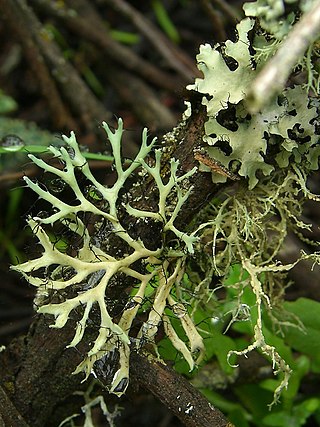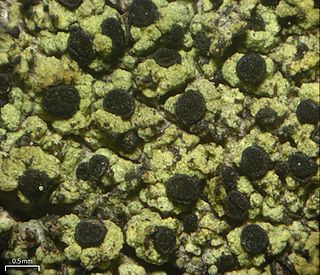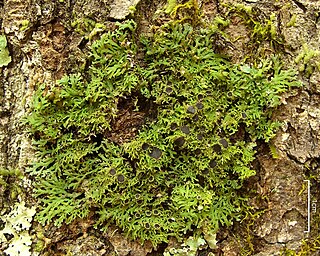
The Physciaceae are a family of mostly lichen-forming fungi belonging to the class Lecanoromycetes in the division Ascomycota. A 2016 estimate placed 19 genera and 601 species in the family.
Culbersonia is a fungal genus in the family Caliciaceae. This is a monotypic genus, containing the single foliose lichen Culbersonia nubila. This species, which grows on trees and rocks, is found in dry subtropical regions of the world, particularly in Africa and Central America.
Coscinocladium is a genus of two species of lichenized fungi in the family Physciaceae.

Anaptychia is a genus of lichen-forming fungi in the family Physciaceae.

Pyxine is a genus of foliose lichens in the family Caliciaceae. The genus has a widespread distribution in tropical regions.

Physconia is a genus of lichen-forming fungi in the family Physciaceae. It has about 25 species. The genus was circumscribed by Czech lichenologist Josef Poelt in 1965, with Physconia pulverulenta assigned as the type species.

Phaeophyscia is a genus of lichen-forming fungi in the family Physciaceae.

Rinodina is a genus of lichen-forming fungi in the family Physciaceae. The genus has a widespread distribution and contains about 265 species. It is hypothesized that a few saxicolous species common to dry regions of western North America, southern Europe, North Africa and central Asia may date back 240 million years to the Middle Triassic.

The Caliciaceae are a family of mostly lichen-forming fungi belonging to the class Lecanoromycetes in the division Ascomycota. Although the family has had its classification changed several times throughout its taxonomic history, the use of modern molecular phylogenetic methods have helped to establish its current placement in the order Caliciales. Caliciaceae contains 36 genera and about 600 species. The largest genus is Buellia, with around 300 species; there are more than a dozen genera that contain only a single species.

Lichens are symbiotic organisms made up of multiple species: a fungus, one or more photobionts and sometimes a yeast. They are regularly grouped by their external appearance – a characteristic known as their growth form. This form, which is based on the appearance of vegetative part of the lichen, varies depending on the species and the environmental conditions it faces. Those who study lichens (lichenologists) have described a dozen of these forms: areolate, byssoid, calicioid, cladoniform, crustose, filamentous, foliose, fruticose, gelatinous, leprose, placoidioid and squamulose. Traditionally, crustose (flat), foliose (leafy) and fruticose (shrubby) are considered to be the three main forms. In addition to these more formalised, traditional growth types, there are a handful of informal types named for their resemblance to the lichens of specific genera. These include alectorioid, catapyrenioid, cetrarioid, hypogymnioid, parmelioid and usneoid.

Caliciales is an order of mostly lichenized fungi in the class Lecanoromycetes. It consists of two families: Caliciaceae and Physciaceae, which together contain 54 genera and more than 1200 species. The order was circumscribed by American botanist Charles Edwin Bessey in 1907.
Endohyalina is a genus of 10 species of corticolous lichens in the family Caliciaceae. The genus was circumscribed by Bernhard Marbach in 2000, with Endohyalina rappii designated as the type species.

Pyxine subcinerea is a species of foliose lichen in the family Caliciaceae. It has a pantropical distribution, and typically grows on bark, but less commonly on rocks. The lichen is characterised by its yellow medulla, soralia on the margins on the lobes that make up the thallus, and the presence of the chemical lichexanthone in the cortex.

Leucodermia is a genus of lichen-forming fungi in the family Physciaceae.

Calicium pinicola is a species of lignicolous (wood-dwelling), crustose lichen in the family Caliciaceae. It is widely distributed in Europe, and also occurs in the United States.
Kashiwadia is a genus of lichen-forming fungi in the family Physciaceae. The genus was circumscribed in Sergey Kondratyuk, László Lőkös, and Jae-Seoun Hur in 2014 to contain the species Physcia orientalis, after molecular phylogenetic analysis showed that the taxon occupied an isolated phylogenetic position in the Physciaceae. An additional five species were added to the genus in 2021. The genus name honours Japanese lichenologist Hiroyuki Kashiwadani, who originally described the type species.
Physconia muscigena is a species of lichen in the family Physciaceae. It exhibits a foliose growth form with lobes that are generally ascending and concave at the tips. The upper cortex is grey-brown to brown in color and often mostly to completely pruinose.

Kurokawia is a genus of lichen-forming fungi in the family Physciaceae. It has seven species of foliose lichens. The genus, circumscribed in 2021, has Kurokawia isidiata as the type species.
Klauskalbia is a genus of lichen-forming fungi in the family Physciaceae. It has four species of foliose lichens.

Kurokawia palmulata is a species of corticolous (bark-dwelling), foliose lichen in the family Physciaceae.













